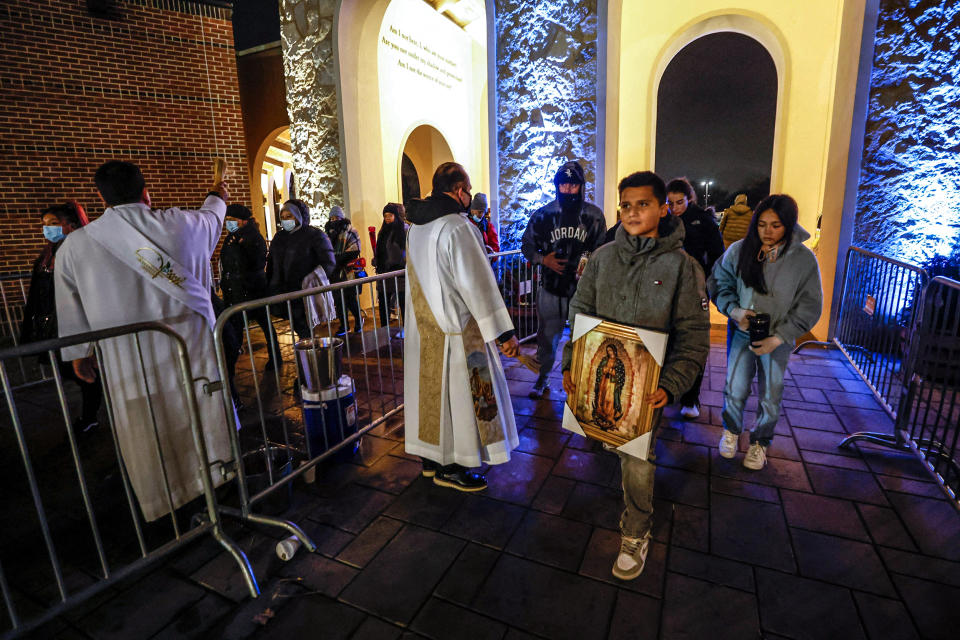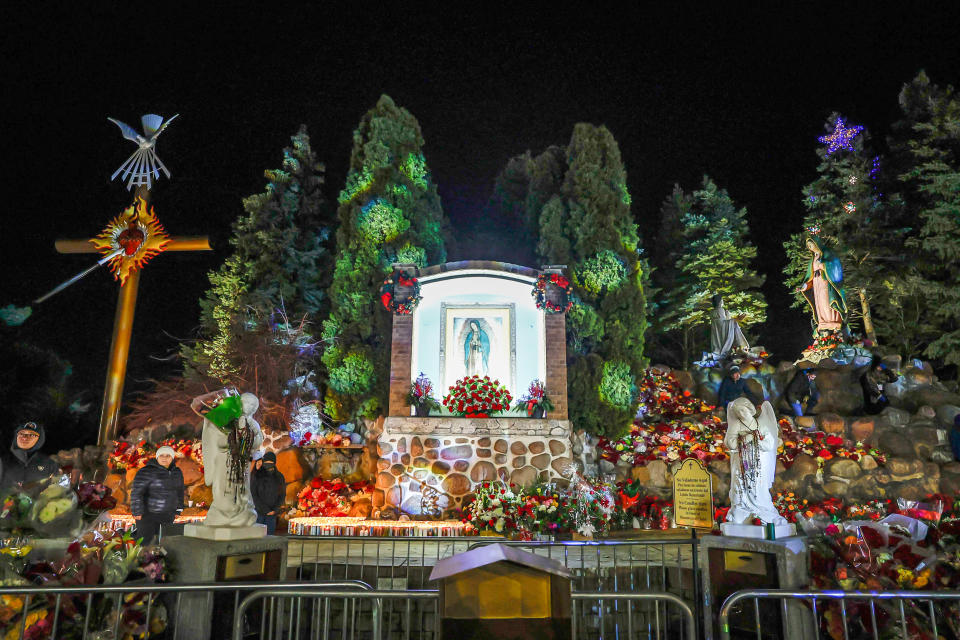In the Midwest, thousands make a pilgrimage to commemorate the Virgin of Guadalupe
- Oops!Something went wrong.Please try again later.
A church in the Midwest has become a symbol for a cherished Catholic tradition that originated in Mexico and is being celebrated by millions of U.S. Catholics, predominantly Mexican Americans.
Thousands of people have made a pilgrimage to Des Plaines, Ill., to honor Mexico's patron saint, the Virgin of Guadalupe. The Feast of Our Lady of Guadalupe is celebrated on Dec. 12.
“Whether it’s rain, sleet, snow, blizzard, freezing cold, they’ll come, they’ll keep coming,” said the Rev. Esequeil Sanchez, rector of the Shrine of Our Lady of Guadalupe, in Des Plaines. “We really know what this means at the heart of the Latino community when you got people walking on the street from Chicago all the way to Des Plaines." The city of Des Plaines is about 20 miles driving distance from Chicago.
From necklace pendants to neighborhood murals, the Virgin of Guadalupe is one of the most prominent symbols in Mexican culture, and the image holds a significant place in the hearts of many Mexican Americans.
Sanchez oversees the Virgin of Guadalupe celebrations at the Des Plaines church. “Last year we had 400,000 that came to visit Our Lady," Sanchez said.
“Other cultures have seen the way we show our faith and said we want a piece of that — we want to celebrate with you and they join us,” the reverend said, highlighting how the bilingual celebration has attracted members of the Indian and Polish communities too.
An outdoor mass was held Sunday night at Our Lady of Guadalupe in Des Plaines. Some made the pilgrimage on foot to show devotion despite the blustery temperatures of the Midwest.

“We didn’t even feel the walk,” said Homero Trujillo, a visitor who came Sunday night from Palatine and walked four hours with a picture of Our Lady of Guadalupe in hand, told NBC News Chicago.
“And what I can say is just, when you come with faith, you don’t feel nothing,” he said of the walk in the Illinois winter. “All of my family, we have faith in her, ever since I was a little kid.”
While many do the pilgrimage to Des Plaines as a testimony to their Catholic faith, in some cases it is to complete a religious offering to the Virgin because many are unable to visit Mexico’s Basilica.
Traditionally, Catholic Mexicans pay tribute on Dec. 12 by bringing roses to her altar during the Catholic mass, sometimes accompanied by mariachi bands.
At the shrine in Des Plaines, celebrations began on Dec. 3 with an equestrian pilgrimage of over 600 horses and riders who came to show their devotion to the patroness. They came from all over the Midwest, including Michigan, Ohio, Indiana and across Illinois, adorned in accouterments and carrying Mexican flags for the cavalcade.
This year, over 200 semi-trucks arrived for the annual Mass celebrated for the transportation industry drivers and their families. Even lowriders were a part of the commemoration.
Dec. 12, also known as El Día de Nuestra Señora de Guadalupe, marks the last of several occasions in which the Virgin Mary appeared to Juan Diego, an Indigenous peasant, in 1531. She repeatedly asked him that a church be built on the side of a hill outside of Mexico City.
As tradition holds, when Juan Diego went to the bishop and told him what had taken place, he demanded proof. The Virgin then reappeared to him on the Hill of Tepeyac and instructed him to bring roses to the bishop, even though it was winter. As the story goes, Juan Diego appeared in front of the bishop and opened his tilma, or Aztec cloak, showing the roses and the Virgin's image, that today is on display at Mexico’s Basilica.
According to the story, the Virgin spoke Nahuatl, Juan Diego's Indigenous native language and appeared with darker complexion than previous images, which is why she is sometimes named “La Virgen Morena” — The Dark-Skinned Virgin.
“The tilma (or cloack) itself, it's a codex. If you’re a native Indian in Juan Diego’s time ... they could actually read the symbols,” Sanchez said, as he explained how the story emphasized the connection the saint made to Mexico Indigenous community.
This became the origins of how the Virgin of Guadalupe came to be seen as an advocate for the oppressed. To this day, the Concheros dance, from the Aztecs and Mexicas, is used to honor her, a distinct depiction of the blending of cultures through this religious event.

In many immigrant households, the connection to the patron saint has given many the courage to pursue a better life away from their native home.
The reverend said his own parents immigrated from La Purísima, in the state of Durango, Mexico, to the U.S. with only third-grade education and made a life for him and his six siblings.
Many immigrants don't have much, but their faith that gives them the resilience to make it when the odds are against them.
“When you see a pilgrim come and they have their heart in their hand,” Sanchez said, “they’re coming looking for a miracle.”
The reverend noted that the Virgin is the single most important female figure in Christianity, and in Mexican culture it represents the importance of a mother’s role.
Traditionally, men would go work to provide for the family and the mother would run the household and raise the children, having a large role in shaping future generations.
“A dad will teach you how to make a living, mom will teach you why you live,” Sanchez said. While patriarchal households have historically been the norm in Mexican culture, the image of the mother of Jesus was a reminder of the respect that women deserve and the importance they hold.
“No new life comes without a woman,” Sanchez said.
This article was originally published on NBCNews.com

